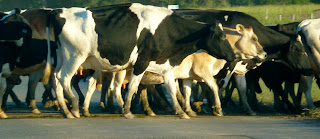The Queensland Government's solution is to let them into national parks to graze, an idea that hasn't gone down too well. The National Parks Association of Queensland is alarmed.
'National Parks are there to conserve our wild animals, plants and landscapes – not to be used as cow paddocks! This is a disturbing move, and currently would constitute a breach of the Nature Conservation Act.'Federal Environment Minister Tony Burke has gone further, and said no. Another stand-off twixt Feds and State. Last year he stood in the way of the reintroduction of cattle into the Alpine National Park of Victoria.
The cattle farmers of northwest Queensland are not just suffering from a lack of rain. Cattle prices are low and farmers have not recovered their incomes since the temporary ban on live cattle exports to Indonesia in 2011. They allege that Indonesia still lacks confidence in the Australian beef market. Bush fires further added to their woes.
The national parks chosen are not necessarily national parks as we know them. Some may be former grazing lands purchased by the previous State Government since 2010 with a view to increasing Queensland's small percentage of land (compared with other states) given over to national parks. The National Parks Association called for these roughly 400,000 hectares to be gazetted as national parks earlier this month. But the State Government is dragging its feet until a 'scientific' review of all Queensland national parks is complete. That's 12.5 million hectares.
The areas currently earmarked to be used as temporary emergency feedlots are not easy to identify. It is claimed that five national parks and eight reserves are involved. One I have managed to identify is Blackbraes Resource Reserve. This was formerly Blackbraes Pastoral Holding, which was gazetted in 1998. A grazier from near Einasleigh in Northern Queensland has been told she can graze 1000 of her cattle on Blackbraes. (I have no idea what a Resource Reserve is, before you ask.)
There are many arguable aspects of the proposed grazing plan. Many national parks have not been adequately maintained and are overrun by invasive plants species. An uncontrolled undergrowth build-up provides 'fuel' for bush fires that decimate fauna and flora. In theory, grazing animals help to reduce weed infestations. The Government claims that what they are proposing will be a temporary measure, for six or 12 months, so damage by the cattle would be minimal. The RSPCA is in favour because of the animal welfare issues: 25,000 cattle may have to be culled if farmers cannot feed them.
Government-subsidised food could be dropped for starving cattle, but short-term temporary measures are not the answer. Greens Queensland Senator Larissa Waters claims the Government is not addressing the longer-term problems for graziers of climate change.
And then there are those who believe farming practices in Australia need complete overhaul in terms of fertility maintenance and water management. Peter Andrews, grazier and racehorse breeder, knows all about resuscitating run-down grazing properties and restoring fertility to parched land. He calls his methods natural sequence farming, and his book Back from the brink: how Australian's landscape can be saved should be essential reading for rural landowners.
There is no reason why responsible grazing cannot be combined with the successful conservation of Australia's rich biodiversity. It happens at Bimblebox Nature Refuge, for instance. Privately owned productive land has long been recognised for the important role it can play in landscape conservation and is at the heart of the National Reserve System*.
The current plight of Bimblebox illustrates, however, that even when corrective measures are in place, big bucks and weak governments combine to render them meaningless. Cattle and shooters roaming through national parks; mining companies devastating nature refuges; they amount to carelessness with this country's remarkable landscape.
* http://www.environment.gov.au/parks/nrs/about/protected-areas/index.html







No comments:
Post a Comment